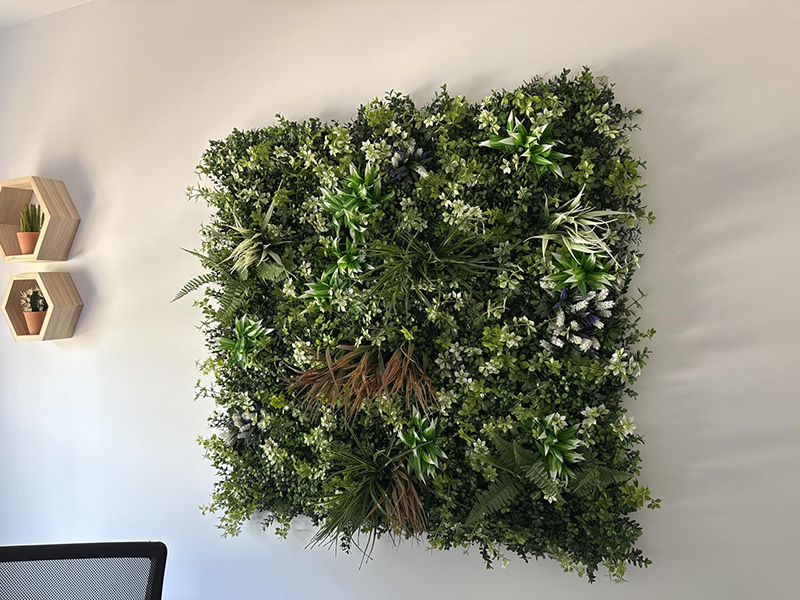The integration of 3D artificial vertical gardens into urban and indoor environments requires careful attention to safety to prevent accidents, structural failures, or health risks. These installations must balance aesthetic appeal with robust design and maintenance practices. This article explores critical safety factors, including structural stability, fire resistance, plant health, and user access, to ensure the safe deployment of vertical gardens.
Vertical gardens must be designed to withstand mechanical stresses, including the weight of plants, substrate, water, and environmental forces like wind or seismic activity. The supporting structure, whether attached to a building facade or freestanding, must be engineered to distribute loads evenly and prevent collapse. For example, modular systems with lightweight frames are preferred for high-rise buildings to minimize additional stress on the structure.
Regular inspections are essential to detect signs of wear, corrosion, or detachment. Fasteners, anchors, and joints should be checked for rust or loosening, especially in coastal or humid regions where corrosion is accelerated. Additionally, the garden’s design should account for future growth, ensuring that increasing plant biomass does not exceed the structure’s load limits.
Fire safety is a paramount concern, particularly in urban settings where vertical gardens are installed near buildings or public spaces. The materials used in the garden, including planting modules, substrates, and structural components, should be non-combustible or treated with fire-retardant coatings. For instance, metal frames and mineral wool substrates are preferable to highly flammable organic materials like untreated wood or peat moss.
Plant selection also plays a role in fire resistance. Species with high moisture content and low flammability, such as succulents or ferns, are safer choices than dry, resinous plants. Maintaining adequate spacing between modules and ensuring proper irrigation reduces the risk of fire spread. In regions prone to wildfires, vertical gardens should incorporate firebreaks or be located at a safe distance from flammable structures.
The health of plants in vertical gardens directly impacts safety. Diseased or pest-infested plants can weaken the system, leading to module failure or plant detachment. Regular monitoring for signs of decay, mold, or insect infestations is necessary to prevent structural damage or air quality issues. For example, mold growth on wet substrates can release spores, posing respiratory risks to occupants.
Allergen management is another critical aspect. Plants known to produce high levels of pollen or irritants, such as ragweed or certain grasses, should be avoided in indoor or densely populated urban areas. Opting for hypoallergenic species or female plants (which produce less pollen) can minimize health risks. Additionally, proper ventilation in indoor vertical gardens reduces the concentration of airborne allergens.
Vertical gardens require regular maintenance, including pruning, irrigation checks, and module replacement. Ensuring safe access for maintenance personnel is vital to prevent falls or injuries. Installing guardrails, harness anchor points, or retractable platforms on tall structures reduces the risk of accidents. Additionally, training staff on safe handling practices, such as using proper lifting techniques or wearing protective gear, minimizes on-site hazards.
In public spaces, vertical gardens should be designed to prevent unauthorized access, especially by children. Fencing or barriers can deter climbing, while avoiding sharp edges or protruding components reduces the risk of cuts or scrapes. Clear signage indicating maintenance zones or caution areas further enhances safety.
Irrigation systems in vertical gardens must be designed to prevent water leakage or overflow, which can cause structural damage or electrical hazards. Drip irrigation with moisture sensors is preferred over overhead sprinklers to minimize water runoff. Additionally, ensuring proper drainage channels and waterproofing behind the garden prevents moisture infiltration into building walls, which could lead to mold or rot.
Electrical components, such as pumps or lighting, must comply with safety standards to prevent shocks or fires. Enclosing wiring in waterproof conduits and using ground-fault circuit interrupters (GFCIs) in wet areas are essential precautions. Regular testing of electrical systems and prompt repair of damaged components ensure ongoing safety.
Addressing safety considerations in 3D artificial vertical gardens requires a proactive approach that encompasses structural design, material selection, plant health, and user access. By prioritizing fire resistance, load-bearing capacity, and maintenance protocols, stakeholders can create vertical gardens that are not only visually appealing but also safe for occupants and the surrounding environment. As vertical gardens become more prevalent in urban planning, adhering to these safety principles will be critical to their widespread adoption.

Contact: Amy
Phone: 86-15311787313
E-mail: info@foszmac.com
Whatsapp:86-15311787313
Add: Fengtai District, Dacheng Road, No.24 Building, Room 203, Beijing, China